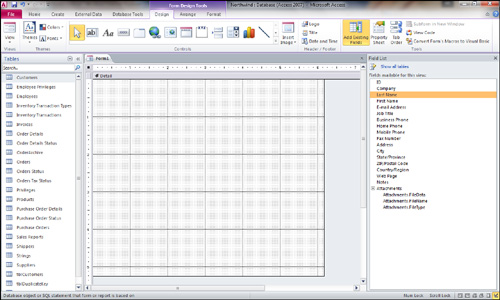To work with a form effectively, you must initially learn how how to operate its controls. The sections which follow the cover the processes to be adding controls to a form, and then selecting,
moving, sizing, deleting, and aligning those controls. The text also includes the process to change properties of control and to change the order of label of controls on a form.
Add Fields to a Form
You can use the Field List window to easily add
controls to a form. The Field List window contains all the fields that
are part of the form’s record source. The record source
for a form is the table, query, or embedded SQL (Structured Query
Language) statement that produces the data for the form. For example,
in Figure 1, the form’s record source is the Customers table. The fields listed in the Field List window are the fields that make up the Customers
table. To add controls to a form, you drag and drop fields from the
Field List onto the form. Each field becomes a control on the form with
the control type appropriate for that field. For example, whereas a
Text field appears as a text box, a Yes/No field appears as a check
box. Follow these two steps to add a control to your form:

1. | Make
sure the Field List window is visible. If it isn’t, click the Add
Existing Fields button in the Tools group on the Design tab of the
Ribbon.
|
2. | Locate
the field you want to add to the form; then click and drag the field
from the field list to the place on the form where you want it to
appear. The location you select becomes the upper-left corner of the
text box, and the attached label appears to the left of where you
dropped the control.
|
A control is an object that you add to a form or report. Types of controls include text boxes, combo boxes, list boxes, and check boxes.
Add Multiple Fields to a Form at the Same Time
To add multiple fields to a form at the same time, complete the following steps:
1. | Select several fields from the field list.
|
2. | Hold
down the Ctrl key to select noncontiguous (not together) fields or the
Shift key to select contiguous (together) fields. For example, if you
hold down the
Ctrl key and click three noncontiguous fields, each of these three
fields is selected. If you click a field, hold down the Shift key, and
click another field, all fields between the two selected fields are
selected. If you want to select all the fields in a list, you
double-click the field list title bar, and then click and drag any one
of the selected fields to the form; all the fields are then added to
the form simultaneously. |